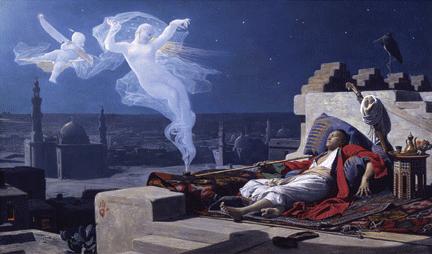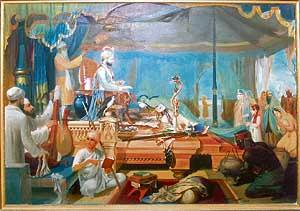 When I deliver training courses no other topic generates as much fascination amongst participants as the subject of interpreting dreams. It seems each person is curious to unravel some of the mystery of their nocturnal visions and gain access to the insights and wisdom they believe are locked in those images.
When I deliver training courses no other topic generates as much fascination amongst participants as the subject of interpreting dreams. It seems each person is curious to unravel some of the mystery of their nocturnal visions and gain access to the insights and wisdom they believe are locked in those images.
A good place to start is an understanding of where our dreams come from. For this we must look at the mind and it’s useful to apply the analogy of an iceberg. The tip of the iceberg visible above the water can be likened to our conscious mind; all that we are aware of in the present moment. The conscious mind can deal with about 5 to 7 tasks or pieces of information at any one time and is responsible for linear, analytical thinking involving factual information and numbers.
The 90 percent or so of the iceberg which is under the water and can’t be seen is similar to our unconscious or ‘sub’conscious mind. It takes care of all the thousands of processes going on in the body which keep us alive. The unconscious mind governs feelings, intuition and creativity. It also serves as a huge store house for our life memories and the skills we’ve already learnt. Sometimes also called the right brain the unconscious mind communicates in a language of images, symbols, metaphors and stories and of course dreams.
I believe while we are asleep at night the unconscious mind isn’t just repairing and healing our bodies, it’s also working through the emotional issues we face in our waking lives and attempting to resolve and heal them too.
Dreams can provide us with guidance and reassurance. They can deliver important messages and warnings, shedding light on areas of concern we are perhaps overlooking. Highlighting our fears as well as our deepest desires. So how can you know what your dreams mean?
There are four basic steps. The first is to record your dream. This is best done in a journal. I find spiral bound hard back notebooks are best, since they are the easiest to write in. You can get up to 70 percent more information from a dream by writing it down than simply reflecting on it in your mind. This is because the process of writing gets the dream out of your head and in front of you allowing for much greater clarity. So imagine your dream is like a film you’ve just watched and write it down like a story; ‘I was in such and such a place when this happened and then I …’ don’t worry if you can’t remember all of it, even a snippet can be quite revealing. To improve recall try to wake up naturally; relax for a few moments and gently focus on your dream, this will help to bring it into conscious awareness.
 Once you’ve described the ‘story’ of the dream you can begin to break it down by making a list of all the dream symbols. These are the naming words or nouns; the places, people, animals and objects contained in the dream.
Once you’ve described the ‘story’ of the dream you can begin to break it down by making a list of all the dream symbols. These are the naming words or nouns; the places, people, animals and objects contained in the dream.
Now you’re ready to start your interpretation. Take each dream symbol in turn and ask yourself ‘What does this person represent to me in my life?’, ‘What does this animal/object remind me of?’ or ‘What does this place represent to me?’ and write your answer next to each symbol.
The meanings of symbols are always unique to each individual. A lost handbag in one woman’s dream may represent concerns about losing something she places a lot of importance on such as a job or relationship, because in waking life the handbag normally contains her valuables; money, keys, phone etc. The same dream symbol for another woman could indicate worry about her self image or appearance because the handbag usually has her make-up items in it. Many people find when they have been interpreting their dreams for sometime; they begin to build up a personal dream dictionary, made up of re-occurring symbols which are unique to them.
By the time you’ve taken each symbol and discovered it’s meaning for you, you’ll have most of the message the dream is communicating. The final step is about uncovering the feelings and emotions. These are very important clues as to which aspects of the dream you need to pay most attention to. The question to ask here is; ‘Which scene contains the most energy?’ or ‘Which part of the dream really stands out?’
The unconscious mind produces different types of dreams. It has the capacity to jump forwards in time resulting in prophetic dreams, foretelling events that have yet to take place in real life. It can go backwards too, giving us glimpses into our past lives. The unconscious mind can also pick up and communicate to us information from thousands of miles away. There are various kinds of spiritual dreams too. One type is where the karma of the dreamer is reduced by experiencing the event which would have happened in waking life through the medium of a dream. There is a beautiful Sakhi illustrating this.
 It’s about a King who comes to Guru Hargobind Sahib’s Darbar. He is troubled to hear that karam cannot be dissolved and asks ‘what is the purpose of coming here then?’ Advised that the answer would be given the following day, the King retires and falls asleep. In his dream he is a very poor man, suffering much hardship. He is relieved to awaken in the morning and joins the Guru for an expedition into the nearby forest.
It’s about a King who comes to Guru Hargobind Sahib’s Darbar. He is troubled to hear that karam cannot be dissolved and asks ‘what is the purpose of coming here then?’ Advised that the answer would be given the following day, the King retires and falls asleep. In his dream he is a very poor man, suffering much hardship. He is relieved to awaken in the morning and joins the Guru for an expedition into the nearby forest.
Somehow the King becomes separated from the rest of the party. Trying to find his way he stumbles upon some huts and approaches the family living there. All of a sudden he is surrounded; each person is overjoyed, believing the King to be their relative who had been lost, no member of the family is prepared to let him go despite his protests. The King is held against his will, filled with sorrow he begins to contemplate the life he saw in his dream. Just then Guru Sahib arrives. He takes the family to the spot where their lost relative had died and was buried, after uncovering the grave they agree to let the King go. In this way the King comes to understand that while karam cannot be wiped out they can be significantly reduced by coming to Guru’s Darbar. The fate which would have befallen him was experienced in a single dream; as a result the King was saved from a lifetime of misery.
From helping us to find solutions to our everyday problems through to settling our karmic debts, dreams play an important role in our lives. Learning how to interpret them can open the doorway to a hidden treasure.
 Darshan Kaur is based in southeast England and works as an NLP Therapist, providing help for a range of different issues including weight management, stress and relationships.
Darshan Kaur is based in southeast England and works as an NLP Therapist, providing help for a range of different issues including weight management, stress and relationships.
She also delivers personal development training courses to private and public sector organisations.

